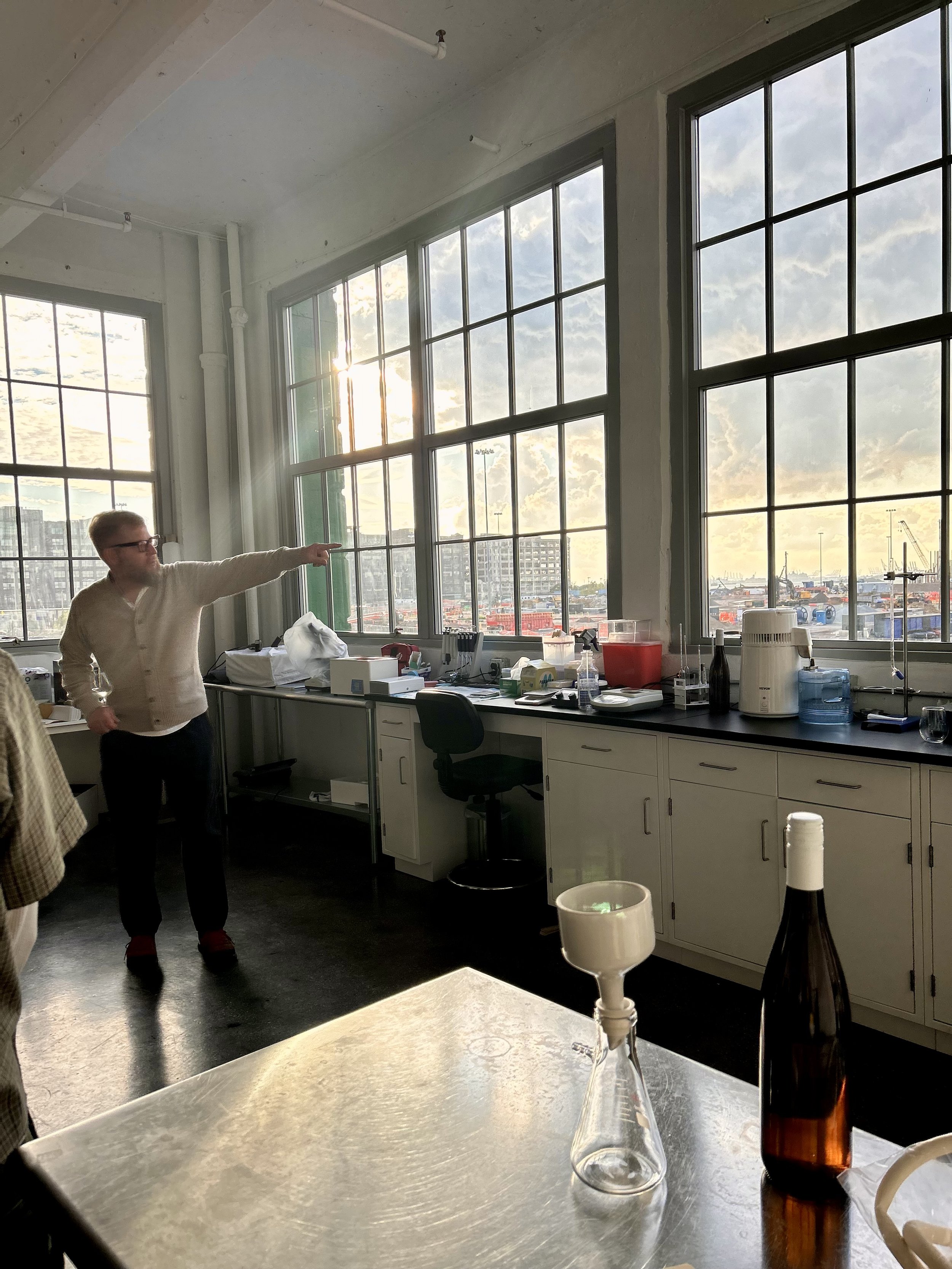Visit to the Bigger, Shinier,Brooklyn Kura
Brooklyn Kura master brewer and co-founder Brandon Doughan giving a tour of the brewery’s expanded Industry City space.
When I realized that my last trip to New York was ending the day before World Sake Day it seemed a shame not to be able to spend it there. So I extended my trip and headed to Brooklyn Kura on October 1. Not only was there a live podcast event by Timothy Sullivan and John Puma of Sake Revolution, I also got to check out the expanded brewery space.
A product of the partnership between Brooklyn Kura (BK) and Hakkaisan Brewery in Niigata Prefecture, the enlarged brewery—which grew from 3,000 to 20,000 square feet and now spreads over two stories—has been in operation since fall 2023. There’s a lot of gleaming equipment for head brewer Brandon Doughan to play with, an expanded taproom and menu, and a Sake Studies Center overseen by Timothy, its director of education. Check out the center’s page for a full list of courses, tastings, and pairing events. Timothy also offers a sake server certification for food and beverage professionals, or those planning to enter the field.
L-R John Puma, Brandon Doughan, Shinobu Kato, Timothy Sullivan.
Brewery Tour
My look at the brewery space came before the live podcast—I jumped on a tour with Brandon and the staff of Kato Sake Works. Both Brandon and Shinobu Kato, founder and head brewer of the other Brooklyn sake brewery were scheduled to be guests on the show.
BK now has the capacity to brew four times (!) the volume of the original brewery, in batches ranging from 500 to 2,000 kilograms (about 1,100 to 44,000 pounds). The larger thermal mass of the mash affords Brandon much great control over its temperature, which results in a pleasing, more rounded flavor to the end product. We often think of small batch as being unique and superior but in this case, not true!
New equipment includes this rice-cooling machine.
The Yabuta press.
New equipment includes a rice cooling machine—which speeds up cooling time no matter what the season and lowers the rice’s exposure to potentially detrimental microbes—and a Yabuta press purchased from Hakkaisan. Brandon and his team also benefitted from visits by three guest brewers from Hakkaisan, who helped with the transition to the large-scale new equipment.
The production volume and Yabuta sake press will yield sheets upon sheets of fragrant sake lees, and I’m looking forward to seeing the interesting ways BK will come up with upcycling those. While a lot of different ideas are under consideration, one thing Brandon would like to experiment with is kasutori shochu, which involves distilling the alcohol-soaked lees.
If you’re used to traditional cedar-lined or stainless steel koji muro (where a portion of the steamed rice is seeded with koji spores), Brooklyn Kura’s is different, lined with food-safe white woven polycloth, which can be washed and sanitized, and helps ensure a clean start to the koji’s mission of rice colonization.
Brandon explaining his vision for sake’s future.
The brewery’s production office and lab on the second floor offers spectacular views across Gowanus Bay and the Red Hook Channel. You can see the South Brooklyn Marine Terminal’s bank of wind turbines, the municipal recycling center a bit to the north, and in the distance, the Statue of Liberty. To Brandon’s chagrin, it is this latter sight that elicits the most excitement and picture taking among Japanese visitors, even more than the sight of his prized equipment and technological capability.
Among the changes made to BK’s brewing style was transitioning from the traditional two-week sokujō, or rapid-brewing method of making the sake starter, or shubō, to the kō on tōka, or high-temperature saccharification method, which can be completed in about six days. The greater speed is achieved by heating the water, kōji mold, and rice up to the very high temperature of up to 55 centigrade (131 fahrenheit) for five hours to rapidly saccharify the rice, or turn its starch into sugar. It’s then cooled at 20 c (68 f) for another five days. Lactic acid and yeast, normally added to the slower sokujō method at the beginning, are withheld during this period; their microbes would not survive the high temperatures in the early stages. After the starter has cooled, the lactic acid, (which rids the tank of any unwanted microbes) and yeast are added, creating a super-charged fermentation power that shortens the entire fermentation process.
In addition to better brewing tank temperature control, Brandon noted, thanks to new instruments, he can now dial in more exact moisture control at the rice soaking stage. And, with his new lab and tips gleaned from the Hakkaisan kurabito, he can also measure koji enzyme activity.
Bin Bin Jizake #001, the shop’s first private label collaboration., brewed at Brooklyn Kura. Photo by Ramon Frias / Brooklyn Kura.
Sophia Sioris, Brooklyn Kura co-founder and co-owner Brian Polen, and George Padilla. Photo by Ramon Frias / Brooklyn Kura.
Collaborations
While questions of technique may dominate a brewer’s mind, the public may be more interested in fun collaborations. Brooklyn Kura’s latest is with the Greenpoint sake shop Bin Bin, to create the shop’s recently released private label “Jizake Series.” The sake combines an of-the moment natural wine ethos that emphasizes accessibility and “defies the pretentious elitism of traditional wine formalities,” says Bin Bin part owner George Padilla; and the spirit of pre-industrial Japan, when every town had its own sake brewery and almost all sake was “local.” It is also a recognition that New York is a place where sake fans have their pick of fresh local sake, from Brooklyn Kura to Kato Sake Works, to the newly opened Dassai Blue Sake Brewery in Dutchess County. What an amazing time for sake in the city!
To shape the profile of the collaboration sake, George and his colleague at Bin Bin, Sophia Sioris, brought a favorite sake, Harada 80 junmai from Hatsumomiji Brewery in Yamagata Prefecture to taste with Brandon and his brewery co-founder Brian Polen. “We were excited about its low polish rate and the juiciness reminded us a bit of Brooklyn Kura's signature style,” explains Sioris. Jizake #001 stays true to that dry, crisp, and fruity style, and benefits from the brand recognition conferred by Bin Bin’s beloved kawaii (cute) blue-and-white cat mascot. For George, this image, created by longtime collaborator and graphic design partner Isometric Studio, is a key component in fostering a “friendly and inclusive” presentation beckons newcomers into the sake tent.
The combo of fresh taste and huggable brand identity has worked: a run George and Sophia thought would last into 2025 and the shop’s three-year anniversary in March has almost sold out; they’re planning to squeeze in a new release in the next month or two. The few bottles left at the store are priced at $34, or you can try it now at next door Rule of Thirds izakaya in pours priced at $9, $27, and, for a 720 milliliter bottle, $80.
Brandon says there will also likely be a repeat of the “Pizza, Bagels, and Sake,” sake BK made with Kato Sake Works, referencing the three iconic Brooklyn products that all depend on the quality of the local water. And he’s got another in development with Emily Doi at Glenora Wine Cellars.
Terroir, Again
During our back-and-forths, Brandon made an interesting observation: “If there is any terroir to sake, I think it has to do with the equipment and brewers, both of which have changed and will change our sake to some degree.” He doesn’t feel anything has been lost because of the new processes and efficiencies, and hopes the better control he now has will allow for targeting new and interesting goals and directions.
This differs from so much of what other brewers have told me: that terroir is in the water, or in the soil where certain rice varieties grow best, such as Yamada Nishiki in Hyogo, or Omachi rice in Okayama. Or even the cultivation methods that different sake rice farmers use. But Brandon’s take makes since to me, since among the aspects of terroir in wine are the winemaker’s unique style, choices, and techniques. As his tools have become more sophisticated his sakes have become more nuanced, and that, too, is an evolving part of Brooklyn Kura’s terroir.
The brewery’s experiments with domestically grown, sake-specific rice varieties is another aspect of its growing individuality, an aspect—if not of terroir—then at least of the coming of age of American craft sake. The name of Brooklyn Kura’s Grand Prairie junmai ginjo, for example, is a salute to the birthplace of the rice used in the sake: central Arkansas, where ace rice farmers Chris and Mark Isbell have become the most important source of sake rice west of California. You can read more about them in this first of a two-part blog post I wrote.
But, really, let’s not get too hung up on these nerdy terroir, brewing, and rice variety discussions, and be happy that BK sakes, like the domestic sake market itself, keeps getting better every year.








